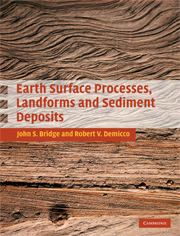Book contents
- Frontmatter
- Contents
- Acknowledgments
- Figure credits
- PART 1 Introduction
- PART 2 Production of sediment at the Earth's surface
- PART 3 Fundamentals of fluid flow, sediment transport, erosion, and deposition
- 5 Unidirectional turbulent water flow, sediment transport, erosion, and deposition
- 6 Air flow, sediment transport, erosion, and deposition
- 7 Multidirectional water flow, sediment transport, erosion, and deposition
- 8 Movement of sediment by gravity
- 9 Generation and movement of volcaniclastic sediment
- 10 Ice flow, sediment transport, erosion, and deposition
- 11 Biogenic and chemogenic depositional structures
- 12 Post-depositional deformation of soft sediment
- PART 4 Environments of erosion and deposition
- PART 5 Sediment into rock: diagenesis
- PART 6 Long-term, large-scale processes: mountains and sedimentary basins
- References
- Appendix: Methods of study of Earth surface processes, landforms, and sediments
- Index
- Plate section
11 - Biogenic and chemogenic depositional structures
from PART 3 - Fundamentals of fluid flow, sediment transport, erosion, and deposition
Published online by Cambridge University Press: 05 June 2012
- Frontmatter
- Contents
- Acknowledgments
- Figure credits
- PART 1 Introduction
- PART 2 Production of sediment at the Earth's surface
- PART 3 Fundamentals of fluid flow, sediment transport, erosion, and deposition
- 5 Unidirectional turbulent water flow, sediment transport, erosion, and deposition
- 6 Air flow, sediment transport, erosion, and deposition
- 7 Multidirectional water flow, sediment transport, erosion, and deposition
- 8 Movement of sediment by gravity
- 9 Generation and movement of volcaniclastic sediment
- 10 Ice flow, sediment transport, erosion, and deposition
- 11 Biogenic and chemogenic depositional structures
- 12 Post-depositional deformation of soft sediment
- PART 4 Environments of erosion and deposition
- PART 5 Sediment into rock: diagenesis
- PART 6 Long-term, large-scale processes: mountains and sedimentary basins
- References
- Appendix: Methods of study of Earth surface processes, landforms, and sediments
- Index
- Plate section
Summary
Biogenic burrows, trails, and trackways: trace fossils
Introduction
Many organisms such as worms, molluscs, crustaceans, insects, sea urchins, and vertebrates move over surface sediment producing trails and trackways, or tunnel through sediment for food, reproduction, and shelter, producing burrows (Figure 11.1). Modern sediments and Phanerozoic sedimentary rocks deposited within the last 542 million years commonly contain well-preserved burrows and trackways, also called trace fossils, ichnofossils, or Lebensspuren (Osgood, 1987; Clarkson, 1998; Prothero, 2004). Ichnology is the study of trace fossils. In addition, certain clams and annelid worms can drill into such solid substrates as corals, rock, and wood for shelter, producing borings. The activities of organisms are also indicated by fecal pellets (Figure 11.1B). Ancient fecal pellets are commonly referred to as coprolites where they are conspicuous. The general biogenic disruption of primary stratification and the formation of randomly organized patches of sediment of varied texture and color is called burrow mottling, bioturbation, and ichnofabric. Unlike body fossils, ichnofossils are generally not transported, and are records of the behavior of animals that lived where their traces are found. This behavior is closely related to the sediment type and the Earth surface environment.
Laminated sediments associated with surface microbial biofilms known as stromatolites and thrombolites are generally not included in ichnology, nor are markings that result from the physical dragging of dead organisms or their body parts across the sediment surface.
- Type
- Chapter
- Information
- Earth Surface Processes, Landforms and Sediment Deposits , pp. 311 - 351Publisher: Cambridge University PressPrint publication year: 2008



